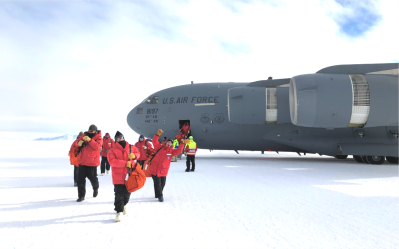Anna Valentine and coworkers arriving at McMurdo Station on a C-17 aircraft carrier in October 2018. Photo courtesy of Valentine.
By McKenzie Williams
Anna Valentine, a 2010 graduate of Libby High School, is back in town enjoying our beautiful summer weather after a rewarding, and cold, five month trip to Antarctica.
Valentine grew up in Troy and attended Libby High School. She is one of seven siblings and she has always had travel on her mind. Her Antarctica adventure wasn’t a vacation though, it was a work trip. She worked for a helicopter company contracted through the National Science Foundation (NSF).
Valentine told The Montanian, “The opportunity to check out Antarctica was unlike anything I have ever done. I’ve always loved to travel, especially when it’s a unique experience like this. And, I’ve always been pretty interested in helicopter work, so it was a good fit.”
While there, Valentine worked six days per week with only one day off, and most of her mornings started early, as early as 4 a.m.
According to nsf.gov, each year, the United States deploys about 700 people to Antarctica to perform scientific research, and about 2,500 people to operate and maintain year-round research station operations and logistical support.
Antarctic travelers include research teams from academia, industry, and the government, as well as military personnel and contracted employees. Many trades and levels of skill are involved.
Valentine’s job was to support scientists on their endeavors throughout Antarctica. A typical day involved preparing passengers for flight, loading and unloading their cargo, and flying with them to remote field landing sites to assist with cargo. Additionally, she was tasked with fueling the helicopter, operating GPS, and maintaining radio communication with McMurdo Station’s Operations on a continual basis. Depending on the schedule, sometimes Valentine would be assigned to stay on the pad facilitating and organizing all incoming and outgoing cargo for upcoming flights.
She also helped facilitate training for those that would be working with helicopters in the field, teaching them proper loading and unloading techniques and how to build loads to be slung from the belly of the helicopter between landing zones. She was also tasked with assisting in Search and Rescue response, when necessary.
“Weather gets in the way a lot,” she said, “and can oftentimes completely derail our schedule for the day, making for quite the dynamic rodeo.”
Even getting to Antarctica depended on the weather. First Valentine took a flight out of Missoula, around the world, to Christchurch, New Zealand. From there, when weather permitted, she and others in her group made their way to McMurdo Station, an American-operated base approximately 1,000 miles away from the South Pole.
At the base, Valentine said, she was lucky to have her own room while many others had to share. At any given time, 800 to 1,000 people live there for various durations in what can best be described as dorms.
Valentine arrived in October ,when their summer, which is our winter, was beginning. Temperatures in Antarctica ranged from 30° F below zero to 25° above zero. It was daylight 24 hours per day, seven days per week, and the time change and isolation were also significant changes, but according to Valentine, they were surprisingly refreshing.
There was no wi-fi, and internet access was extremely slow but she primarily used email to stay in touch, with a calling card for occasional phone conversations.
“I actually really appreciated not having constant communication from my phone or a computer. It really helped create more genuine and personal conversation since no one had the constant distraction of their phone pinging every five minutes,” said Valentine.

